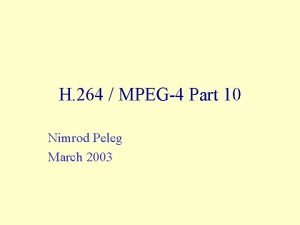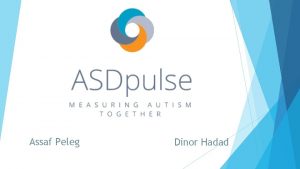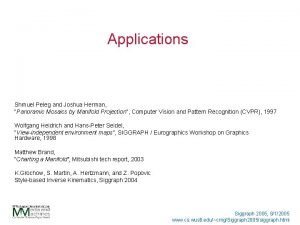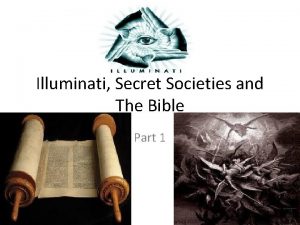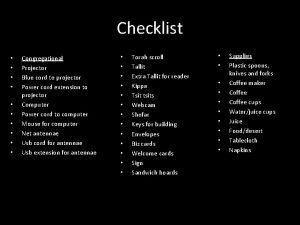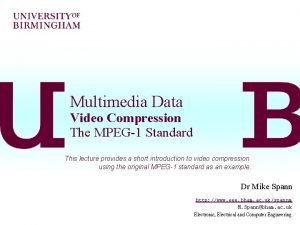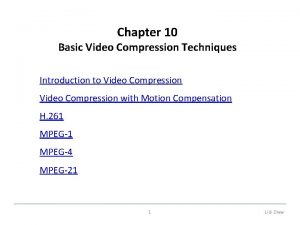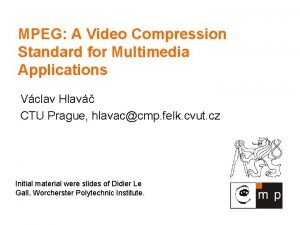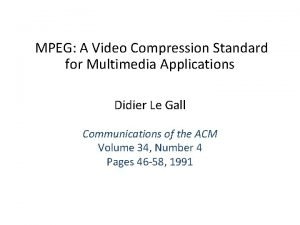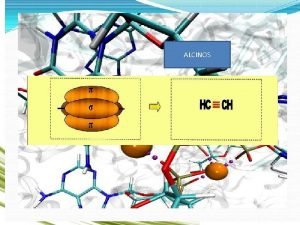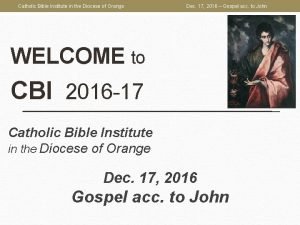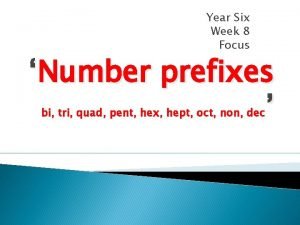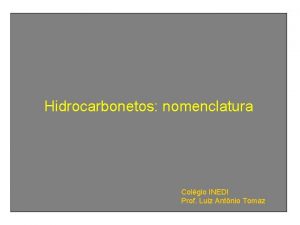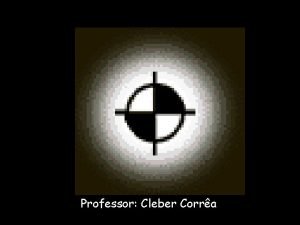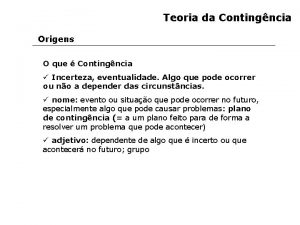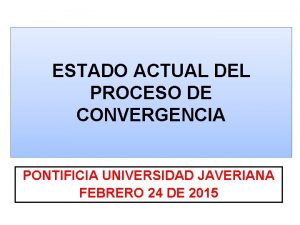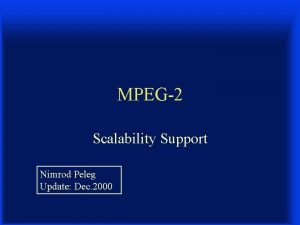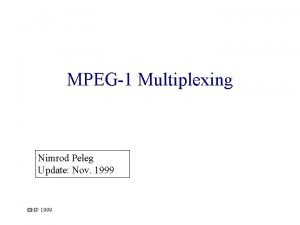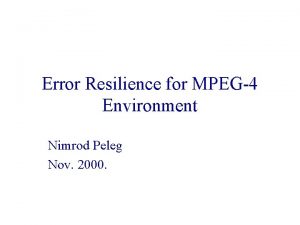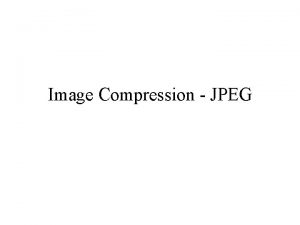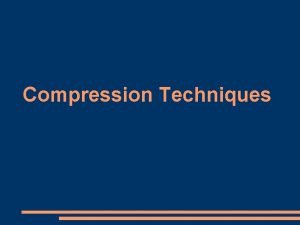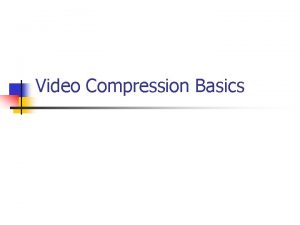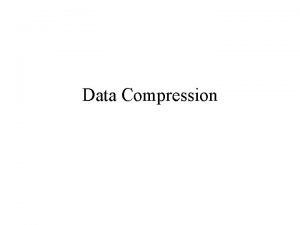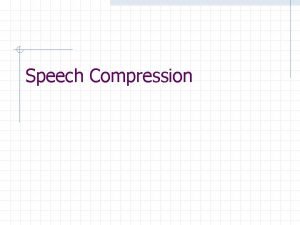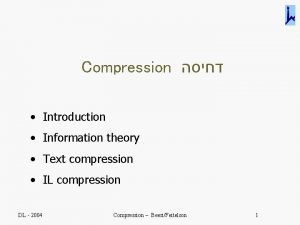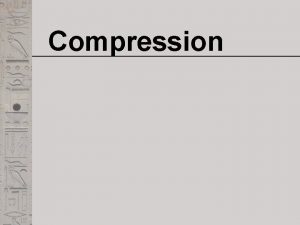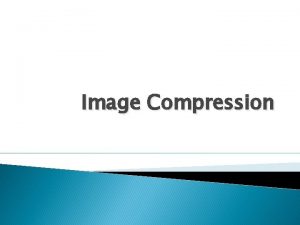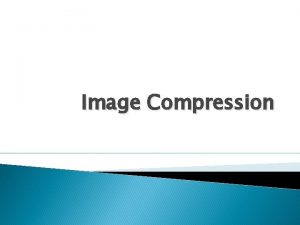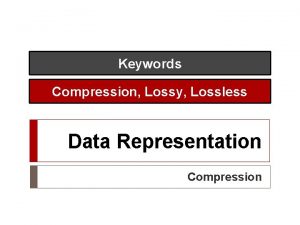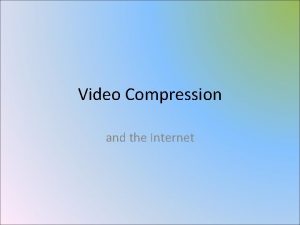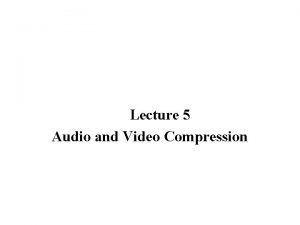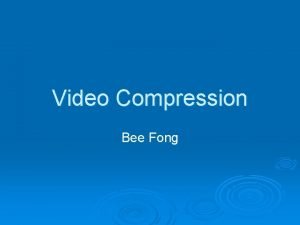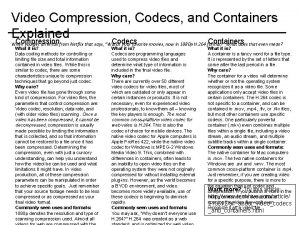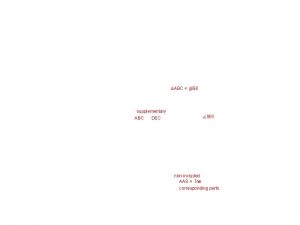Video Compression Concepts Nimrod Peleg Update Dec 2000























- Slides: 23

Video Compression Concepts Nimrod Peleg Update: Dec. 2000

Interframe Compression • The simple way is a frame-by-frame compression (JPEG-like): Limited compression ratio • Interframe compression exploits temporal redundancies due to similarity between successive frames, (In addition to spatial, spectral and psychovisual redundancies in still image compression( • No Random Access at all frames!

Possible Strategies • (3 -D Waveform coding (TC / Sub-Band • Object/Knowledge based coding • Motion Compensation based coding

Motion Compensation Approach • Segmenting each frame to “changed” and “unchanged” regions (Vs. previous frame( • Pixels in changed region are DPCM encoded )between successive frames and following motion compensation(

Frame 2 Macro Block

Motion Compensation (Cont’d( • Amount of changed info. varies from frame to frame (VLC): a buffer needed • A motion detection algorithm needed • MC-DPCM is efficient if displacement vectors estimation is accurate

Motion Compensation (Cont’d( • ideally: motion info for each pixel – too expensive • semantically: motion data for each region or object – second generation coding techniques • simplified: motion info for each 16 x 16 macroblock

Motion Model • Affine motion: – translation, rotation, scale – 6 parameters in 2 D – complex • Simplified translational model: – motion vectors (MV, 2 parameters(

ME Options • optimal motion vector? – investigate all positions within a search window – keep the one with minimum Mean Square Error – MV = corresponding translation

Motion Estimation Techniques l The choice of sending zero MV, is always available, with no cost…and worst results. • Backward prediction – Predict where the pixels in a current frame were in a past frame • Forward prediction – Predict where the pixels in a current frame will go to in a future frame

Motion Estimation Block Matching Method • Motion vector is estimated by pixel domain search procedure • Most popular due to lesser h/w complexity • Basic idea: Frame K+1 Motion Vector Search Window

Matching Criteria • Maximum cross-correlation • Maximum pel matching count (MPC( • Minimum mean squared error (MSE( Not popular in VLSI due to square operation • Minimum mean absolut difference (MAD( Very popular but problematic due to several possible local minima • SNR

Other Parameters • Calculation and implementation • Visual results. . .

Full Search & Zero MV results

Search Procedure • Full search (inside the search window( • Three step • Conjugate direction 3 -Step Conjugate direction Search order Best Match 12 pixels

3 or 4 Step Search Results Full search No search

Conjugate Direction Search

Search Algorithm results Algorithm Ave. SNR(d. B) Full search 28. 46 Zero Search 27. 7 Conjugate 27. 9 Orthogonal 28. 1 Decimation 28. 2 Pyramid and more. . . Caculations 100% (~7 M( 0 2% 3. 6% 33%

MC Transform Coding • Temporal prediction error is 2 -D transform coded by segmenting the displaced frame difference into blocks, and encoding the DCT coeff. of each block • Intra and Inter modes • Field and frame modes

Other MC Compression Techniques • Vector Quantization: Prediction error signal encoded by VQ • Sub-Band Coding: Frame prediction error (residual) is decomposed into 2 -D subbands

Video Compression (Cont’d( • Complete process: – Encode every N frame “JPEG style” – Between the “JPEG style” frames, predict the motion from frame to frame – Subtract the predicted frame from the original one and encode the difference • Compression ratio: about 100: 1 and more

Motion Compensation • frame #0 • difference frame • frame #1 motion compensated difference frame

Prediction Technique Past Frame Current Frame Bidirectional Interpolation Future Frame
 Nimrod peleg
Nimrod peleg Assaf peleg
Assaf peleg Shmuel peleg
Shmuel peleg Ran peleg
Ran peleg Shadow paging recovery technique
Shadow paging recovery technique Nimrod remembrance sunday
Nimrod remembrance sunday Secret societies in the bible
Secret societies in the bible Cush nimrod
Cush nimrod Injection moulding process advantages and disadvantages
Injection moulding process advantages and disadvantages Xxx oooo video
Xxx oooo video Video compression techniques in multimedia
Video compression techniques in multimedia Spatial redundancy in video compression
Spatial redundancy in video compression Spatial redundancy in video compression
Spatial redundancy in video compression Jlh mesure
Jlh mesure Metil acetileno
Metil acetileno Dec 17
Dec 17 Pent oct hept hex
Pent oct hept hex Hidrocarbonetos ramificados
Hidrocarbonetos ramificados Alkanes
Alkanes 8th dec 2014
8th dec 2014 Prop but
Prop but Met et prop but pent hex hept oct non dec
Met et prop but pent hex hept oct non dec Modelo de lawler
Modelo de lawler Dec. 3022/13
Dec. 3022/13
